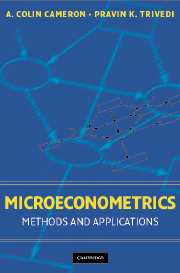 A. Colin Cameron and Pravin K. Trivedi
A. Colin Cameron and Pravin K. Trivedi
GUIDE FOR INSTRUCTORS AND OTHER READERS
The book assumes a basic understanding of the linear regression model with matrix algebra. It is written at the mathematical level of the first-year economics Ph.D. sequence, comparable to W.H. Greene Econometric Analysis (2003).
While some of the material in this book is covered in a first-year sequence,
most of the material in this book appears in second year econometrics Ph.D.
courses or in data-oriented microeconomics field courses such as labor economics,
public economics or industrial organization. This book is intended to be
used as both an econometrics text and as an adjunct for such field courses.
More generally, the book is intended to be useful as a reference work for
applied researchers in economics, in related social sciences such as sociology
and political science, and in epidemiology.
The models chapters have been written to be as self-contained
as possible, to minimize the amount of background material in the methods
chapters that needs to be read. For the specific models presented in
parts four and five (chapters 14-23) it will generally be sufficient to read
the relevant chapter in isolation, except that some command of the general
estimation results in chapter 5 and in some cases chapter 6 will be necessary.
Most chapters are structured to begin with a discussion and example that
is accessible to a wide audience.
For instructors using this book as a course text it is best to introduce
the basic nonlinear cross-section and linear panel data models as early
as possible, skipping many of the methods chapters. The most commonly-used
nonlinear cross-section models are presented in chapters 14-16, and require
knowledge of maximum likelihood and least squares estimation, presented in
chapter five. Chapter twenty-one on linear panel data models requires even
less preparation, essentially just chapter four.
Table 1.2 provides an outline for a one-quarter second-year graduate course
taught at the University of California - Davis, immediately following the
required first-year statistics and econometrics sequence. A quarter provides
sufficient time to cover the basic results given in the first half of the
chapters in this outline. With additional time one can go into further detail
or cover a subset of chapters eleven to thirteen on computationally-intensive
estimation methods (simulation-based estimation, the bootstrap which is
also briefly presented in chapter seven and Bayesian methods); additional
cross-section models (durations and counts) presented in chapters seventeen
to twenty; and additional panel data models (linear model extensions and nonlinear
models) given in chapters twenty-two and twenty-three.
Outline of a twenty-lecture ten-week course:
| Lectures |
Chapter |
Topic |
| 1-3 |
4 |
Review of linear models and asymptotic theory |
| 4-7 |
5 |
Estimation: M-estimation, ML and NLS |
| 8 |
10 |
Estimation: Numerical Optimization
|
| 9-11 |
14,15 |
Models: Binary and multinomial |
| 12-14 |
16 |
Models: Censored and Truncated |
| 15 |
6 |
Estimation: GMM |
| 16 |
7 |
Testing: Hypothesis Tests |
| 17-19 |
21 |
Models: Basic Linear Panel |
| 20 |
9 |
Estimation: Semiparametric |
At Indiana University - Bloomington, a fifteen-week semester long field
course in microeconometrics is based on material in most of Parts 4 and
5 (chapters 14-23). The prerequisite courses for this course cover
material similar to the material in Part 2 (chapters 4-10).